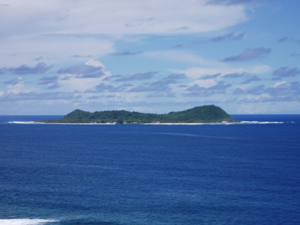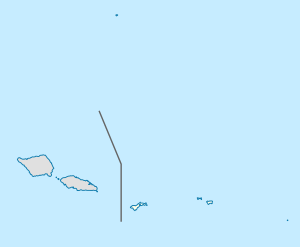Aunuʻu, American Samoa facts for kids
Quick facts for kids
Aunuʻu
|
|
|---|---|
|
Village & Island
|
|
 |
|
| Country | |
| Territory | |
| County | [[Saʻole County|Saʻole]] |
| Area | |
| • Total | 1.517 km2 (0.5857 sq mi) |
| Population
(2020)
|
|
| • Total | 402 |
| Designated: | 1972 |
Aunuʻu is a small volcanic island located near the southeastern coast of Tutuila in American Samoa. It is part of [[Saʻole County]]. The island covers about 0.58 square miles (1.5 square kilometers). In 2010, its population was 436 people.
Aunuʻu is part of the Eastern District. This is one of the two main political areas of American Samoa.
The island is home to the [[Aunuʻu Crater]]. Inside this crater is the Faʻamulivai Marsh. This marsh is the largest freshwater wetland in American Samoa. It formed from water draining into the low crater. This area became a protected National Natural Landmark in 1972. Rare birds like the purple swamphen live here. The Chinese water chestnut also grows only in this marsh in American Samoa.
Since the 1960s, the people of Aunuʻu have mainly grown taro. They also produce a local food called faausi.
Demographics
Aunuʻu has two historical areas: Salevatia and Alofasau. The table below shows how the population has changed over the years.
| Year | Population |
|---|---|
| 2020 | 402 |
| 2010 | 436 |
| 2000 | 476 |
| 1990 | 463 |
| 1980 | 414 |
| 1970 | 425 |
| 1960 | 436 |
Geography
Aunuʻu is the only place in American Samoa where taro is grown in special wet fields called paddy fields. These fields cover about 5% of the island's land. Most of the other land is wet and not good for farming. It is covered by trees, bushes, and weeds.
Aunuʻu is known for growing the best taro in American Samoa. Water from farms flows into Pala Lake and the wetlands. This does not seem to harm the water quality near the coast.
Geology
The island is less than 1 square mile (2.6 square kilometers) in size. About half of this area is a flat plain where the villages are located. Aunuʻu has beaches made of coral and sand. It also has steep cliffs along the sea.
The eastern part of Aunuʻu has a new volcanic cone. The highest point on this cone is 310 feet (94 meters) above sea level. Inside the cone is the Faʻimulivai Marsh, which has a freshwater pond. This crater shows some of the most recent volcanic activity in American Samoa.
Aunuʻu Island has the only quicksand area in American Samoa. It also has the territory's only lakes. Pala Lake is just north of the village. Red Lake is inside the crater. Maʻamaʻa Cove is on the far eastern edge of the crater.
History
The first people settled in the Samoan islands about 2,900 to 3,500 years ago. This is known from old pottery pieces found there. The oldest pieces found in Samoa are from around the same time as those in other Polynesian islands. This suggests that Aunuʻu was also settled around this time.
In the early 1800s, a whaling ship from Aunuʻu was lost at sea near the island. In 1863, the first Mormon missionaries arrived in Aunuʻu from Hawaii. The local leaders welcomed them.
In 1877, a war started on Tutuila. High Chief Mauga escaped to Aunuʻu. The island's warriors defended him from their natural fortress.
In 1887, King David Kalākaua of Hawaii sent his ship, the Kaimiloa, to Samoa. He wanted to form a political alliance. Some Hawaiians from the Kaimiloa stayed on Aunuʻu and married Samoans. On the west coast of Aunuʻu village, there are ruins called Pa Taua. These were once towers that held four cannons from the Kaimiloa. The people of Aunuʻu used these cannons to stop an invasion by canoes. The cannons are now at the Jean B. Haydon Museum in Pago Pago.
Transportation
Aunuʻu has a few government cars. Many families own motorboats. These boats take people to and from the small boat harbor in Auasi on Tutuila.
Hiking on the island can be hard. It is covered in thick forests and bushes. There are also steep cliffs along the south coast. The island has a quicksand area at Pala Lake, near the village. There are also taro swamps behind the village. Maʻamaʻa Cove is on the east side of the island.
Boats that go to and from Aunuʻu can be hired at the Auʻasi boat dock on Tutuila. Aunuʻu is a popular spot for hiking and school trips. The coral reef around Aunuʻu is not often used for snorkeling.
Wildlife
Aunuʻu has about fifty gray ducks. These ducks are called toloa by the local people. These birds have also been seen in other areas like Futiga and Leone. However, they might be part of the group that lives on Aunuʻu.
Notable people
- Aifili Paulo Lauvao (1919–2002) was the governor of American Samoa twice. He started the Democratic Party in the U.S. territory. Governor Lutali worked to protect American Samoa's nature, old sites, and historic buildings.
- Tiaina Baul "Junior" Seau Jr. (1969–2012) was a famous American professional football player. He was a linebacker in the National Football League (NFL). He was chosen for the Pro Bowl 12 times. He was added to the Pro Football Hall of Fame in 2015.
See also
 In Spanish: Aunu'u para niños
In Spanish: Aunu'u para niños



